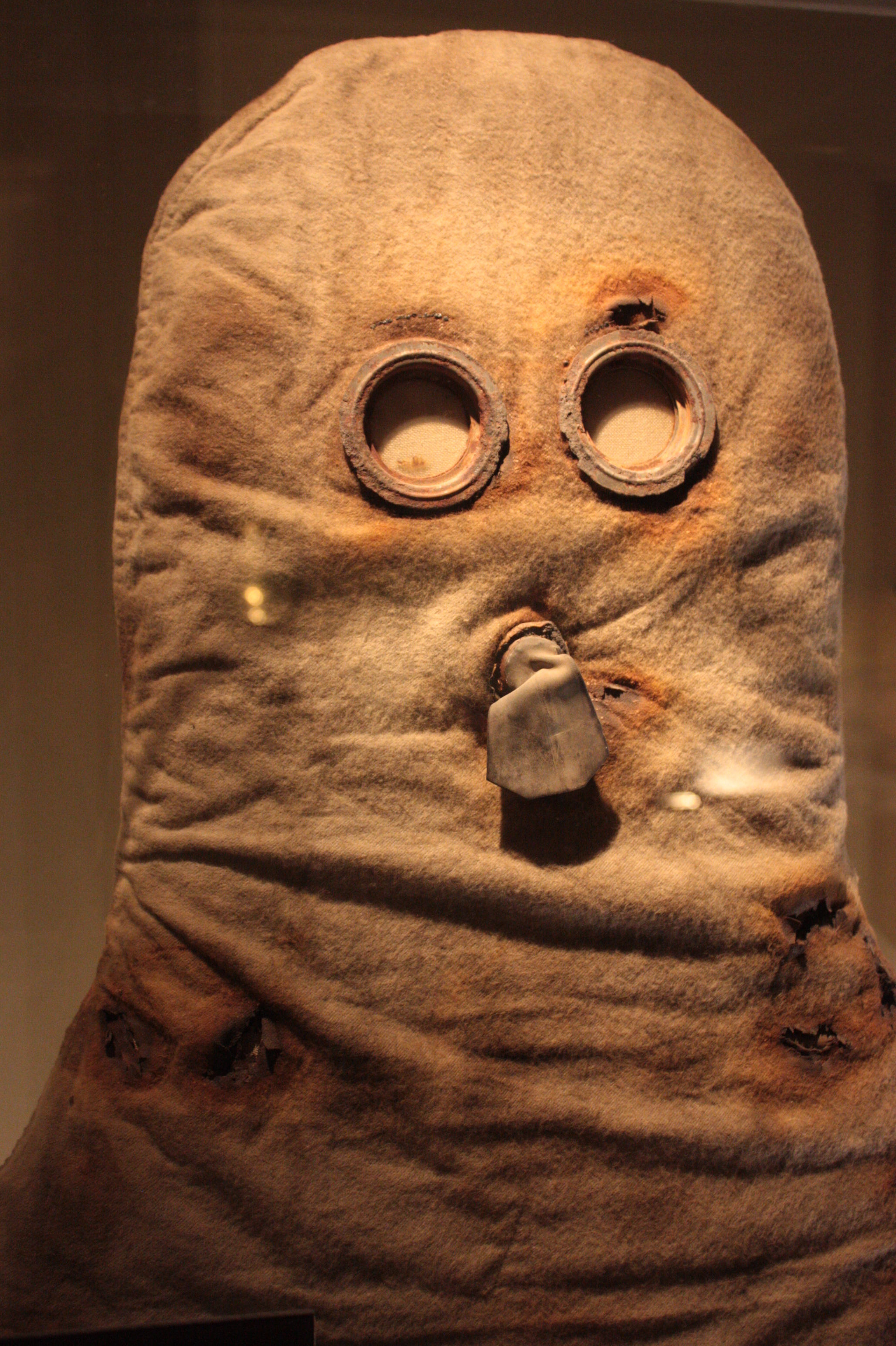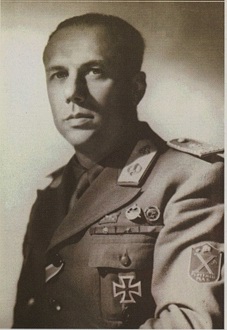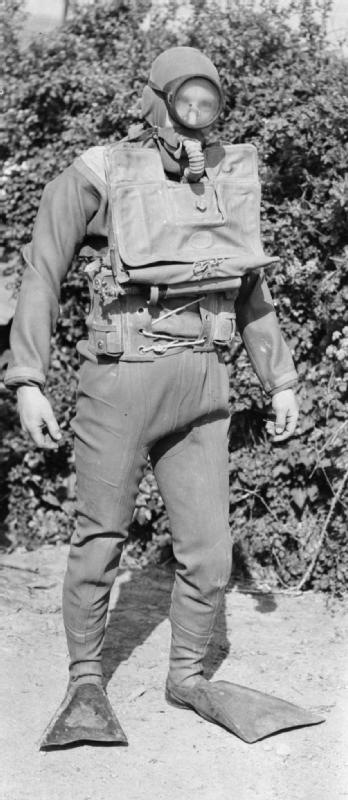|
Lambertsen Amphibious Respiratory Unit
The Lambertsen Amphibious Respiratory Unit (LARU) is an early model of closed circuit oxygen rebreather used by military frogmen. Christian J. Lambertsen designed a series of them in the US in 1940 (patent filing date: 16 Dec 1940) and in 1944 (issue date: 2 May 1944). Etymology The LARU is what the initials SCUBA (Self-Contained Underwater Breathing Apparatus) originally meant; Lambertsen changed his invention's name to SCUBA in 1952; but later "SCUBA", gradually changing to "scuba", came to mean (first in the USA) any self-contained underwater breathing apparatus. (Modern diving regulator technology was invented by Émile Gagnan and Jacques-Yves Cousteau in 1943 and was not related to rebreathers; nowadays the word SCUBA is largely used to mean Gagnan's and Cousteau's invention and its derivatives.) History Lambertsen designed the LARU while a medical student and demonstrated the LARU to the Office of Strategic Services (OSS) (after already being rejected by the U.S. Navy) in a ... [...More Info...] [...Related Items...] OR: [Wikipedia] [Google] [Baidu] |
Rebreather
A rebreather is a breathing apparatus that absorbs the carbon dioxide of a user's breathing, exhaled breath to permit the rebreathing (recycling) of the substantially unused oxygen content, and unused inert content when present, of each breath. Oxygen is added to replenish the amount metabolised by the user. This differs from open-circuit breathing apparatus, where the exhaled gas is discharged directly into the environment. The purpose is to extend the breathing endurance of a limited gas supply, and, for covert military use by frogmen or observation of underwater life, eliminating the bubbles produced by an open circuit system and in turn not scaring wildlife being filmed. A rebreather is generally understood to be a portable unit carried by the user. The same technology on a vehicle or non-mobile installation is more likely to be referred to as a life-support system. Rebreather technology may be used where breathing gas supply is limited, such as underwater or in space, where ... [...More Info...] [...Related Items...] OR: [Wikipedia] [Google] [Baidu] |
Gasmask
A gas mask is a mask used to protect the wearer from inhaling airborne pollutants and toxic gases. The mask forms a sealed cover over the nose and mouth, but may also cover the eyes and other vulnerable soft tissues of the face. Most gas masks are also respirators, though the word ''gas mask'' is often used to refer to military equipment (such as a field protective mask), the scope used in this article. The gas mask only protects the user from digesting, inhaling, and contact through the eyes (many agents affect through eye contact). Most combined gas mask filters will last around 8 hours in a biological or chemical situation. Filters against specific chemical agents can last up to 20 hours. Airborne toxic materials may be gaseous (for example, chlorine or mustard gas), or particulates (such as biological agents). Many filters provide protection from both types. The first gas masks mostly used circular lenses made of glass, mica or cellulose acetate to allow vision. Glass a ... [...More Info...] [...Related Items...] OR: [Wikipedia] [Google] [Baidu] |
Siebe Gorman CDBA
The Clearance Divers Breathing Apparatus (CDBA) is a type of rebreather made by Siebe Gorman in England. The British Royal Navy used it for many years. It was for underwater work rather than for combat diving. The main oxygen diving cylinder, cylinders are on the diver's back. The oxygen cylinders at the front of the diver are for Bailout bottle, bailout. In its basic mode it was an oxygen rebreather; but some of the cylinders could be replaced by diluent cylinders for nitrox mode (which the Navy called "mixture"), and then the set was sometimes called CDMBA. The Royal Navy was using nitrox from 1944, but did not reveal its nitrox techniques, and in the 1960s and afterwards civilian divers had to retread the same ground and develop nitrox diving independently. In later years it was called DSSCCD from "Diving Set, Self-Contained, Clearance Diver". Design The CDBA was very popular with the clearance divers. It is comfortable since there is no cylinder on the middle of the back, no ... [...More Info...] [...Related Items...] OR: [Wikipedia] [Google] [Baidu] |
World War II
World War II or the Second World War, often abbreviated as WWII or WW2, was a world war that lasted from 1939 to 1945. It involved the vast majority of the world's countries—including all of the great powers—forming two opposing military alliances: the Allies and the Axis powers. World War II was a total war that directly involved more than 100 million personnel from more than 30 countries. The major participants in the war threw their entire economic, industrial, and scientific capabilities behind the war effort, blurring the distinction between civilian and military resources. Aircraft played a major role in the conflict, enabling the strategic bombing of population centres and deploying the only two nuclear weapons ever used in war. World War II was by far the deadliest conflict in human history; it resulted in 70 to 85 million fatalities, mostly among civilians. Tens of millions died due to genocides (including the Holocaust), starvation, ma ... [...More Info...] [...Related Items...] OR: [Wikipedia] [Google] [Baidu] |
Decima Flottiglia MAS
The ''Decima Flottiglia MAS'' (''Decima Flottiglia Motoscafi Armati Siluranti'', also known as ''La Decima'' or Xª MAS) (Italian for "10th Assault Vehicle Flotilla") was an Italian flotilla, with commando frogman unit, of the ''Regia Marina'' (Italian Royal Navy) created during the Fascist regime. The acronym '' MAS'' also refers to various light torpedo boats used by the Regia Marina during World War I and World War II. Decima MAS was active during the Battle of the Mediterranean and took part in a number of daring raids on Allied shipping. These operations involved surface speedboats (such as the raid on Souda Bay), manned torpedoes (the raid on Alexandria) and ''Gamma'' frogmen (against Gibraltar). During the campaign Decima MAS took part in more than a dozen operations which sank or damaged five warships (totalling 72,000 tons) and 20 merchant ships (totalling 130,000 GRT). In 1943, after the Italian dictator Benito Mussolini was ousted, Italy left the Tripartite Pac ... [...More Info...] [...Related Items...] OR: [Wikipedia] [Google] [Baidu] |
Siebe Gorman Salvus
The Siebe Gorman Salvus is a light oxygen rebreather for industrial use (including by firemen and in coalmine rescue) or in shallow diving. Its duration on a filling is 30 to 40 minutes. It was very common in Britain during World War II and for a long time afterwards. Underwater the Salvus is very compact and can be used where a diver with a bigger breathing set cannot get in, such as inside cockpits of ditched aircraft. It was made by Siebe Gorman & Company, LTD in London, England. It was designed in the early 1900s. Function Its arrangement can be seen from the image. It is a pendulum-type system with one breathing tube. This type is the Neck Salvus: there was another type, for use on land only, where the counterlung (= breathing bag) hung by his left hip from the cylinder and canister pack. That pack is a metal plate (probably aluminium), with a webbing sheet stuck to one side to protect its user's diving suit or overall. The absorbent canister and the cylinder are fastened ... [...More Info...] [...Related Items...] OR: [Wikipedia] [Google] [Baidu] |
Davis Escape Set
The Davis Submerged Escape Apparatus (also referred to as DSEA), was an early type of oxygen rebreather invented in 1910 by Robert Davis (inventor), Sir Robert Davis, head of Siebe Gorman, Siebe Gorman and Co. Ltd., inspired by the earlier Fleuss system, and adopted by the Royal Navy after further development by Davis in 1927. While intended primarily as an emergency escape apparatus for submarine crews, it was soon also used for Underwater diving, diving, being a handy shallow water diving apparatus with a thirty-minute endurance, and as an SCBA, industrial breathing set. Design The DSEA rig chiefly addressed the problem of Hypoxia (medical) , anoxia threatening a person ascending through water, by providing oxygen; and the associated risk of Barotrauma#Pressure differences while diving , lung over-pressure injury as underwater pressure reduces with reducing depth, which it addressed by managing oxygen pressures. It also provided assistance with buoyancy, both in the ascent ... [...More Info...] [...Related Items...] OR: [Wikipedia] [Google] [Baidu] |
Diving Weight
A diving weighting system is ballast weight added to a diver or diving equipment to counteract excess buoyancy. They may be used by divers or on equipment such as diving bells, submersibles or camera housings. Divers wear diver weighting systems, weight belts or weights to counteract the buoyancy of other diving equipment, such as diving suits and aluminium diving cylinders, and buoyancy of the diver. The scuba diver must be weighted sufficiently to be slightly negatively buoyant at the end of the dive when most of the breathing gas has been used, and needs to maintain neutral buoyancy at safety or obligatory decompression stops. During the dive, buoyancy is controlled by adjusting the volume of air in the buoyancy compensation device (BCD) and, if worn, the dry suit, in order to achieve negative, neutral, or positive buoyancy as needed. The amount of weight required is determined by the maximum overall positive buoyancy of the fully equipped but unweighted diver anticipated duri ... [...More Info...] [...Related Items...] OR: [Wikipedia] [Google] [Baidu] |
Breathing Tube (breathing Apparatus)
A rebreather is a breathing apparatus that absorbs the carbon dioxide of a user's exhaled breath to permit the rebreathing (recycling) of the substantially unused oxygen content, and unused inert content when present, of each breath. Oxygen is added to replenish the amount metabolised by the user. This differs from open-circuit breathing apparatus, where the exhaled gas is discharged directly into the environment. The purpose is to extend the breathing endurance of a limited gas supply, and, for covert military use by frogmen or observation of underwater life, eliminating the bubbles produced by an open circuit system and in turn not scaring wildlife being filmed. A rebreather is generally understood to be a portable unit carried by the user. The same technology on a vehicle or non-mobile installation is more likely to be referred to as a life-support system. Rebreather technology may be used where breathing gas supply is limited, such as underwater or in space, where the enviro ... [...More Info...] [...Related Items...] OR: [Wikipedia] [Google] [Baidu] |
Counterlung
A rebreather is a breathing apparatus that absorbs the carbon dioxide of a user's exhaled breath to permit the rebreathing (recycling) of the substantially unused oxygen content, and unused inert content when present, of each breath. Oxygen is added to replenish the amount metabolised by the user. This differs from open-circuit breathing apparatus, where the exhaled gas is discharged directly into the environment. The purpose is to extend the breathing endurance of a limited gas supply, and, for covert military use by frogmen or observation of underwater life, eliminating the bubbles produced by an open circuit system and in turn not scaring wildlife being filmed. A rebreather is generally understood to be a portable unit carried by the user. The same technology on a vehicle or non-mobile installation is more likely to be referred to as a life-support system. Rebreather technology may be used where breathing gas supply is limited, such as underwater or in space, where the envir ... [...More Info...] [...Related Items...] OR: [Wikipedia] [Google] [Baidu] |
Fullface Mask
A full-face diving mask is a type of diving mask that seals the whole of the diver's face from the water and contains a mouthpiece, demand valve or constant flow gas supply that provides the diver with breathing gas. The full face mask has several functions: it lets the diver see clearly underwater, it provides the diver's face with some protection from cold and polluted water and from stings, such as from jellyfish or coral. It increases breathing security and provides a space for equipment that lets the diver communicate with the surface support team. Full-face masks can be more secure than breathing from an independent mouthpiece; if the diver becomes unconscious or suffers an oxygen toxicity convulsion, the diver can continue to breathe from the mask, unlike a scuba mouthpiece which is normally gripped between the teeth. Full-face diving masks are often used in professional diving. They are relatively rarely used in recreational diving. Function The full-face mask p ... [...More Info...] [...Related Items...] OR: [Wikipedia] [Google] [Baidu] |
Frogmen
A frogman is someone who is trained in scuba diving or swimming underwater in a tactical capacity that includes military, and in some European countries, police work. Such personnel are also known by the more formal names of combat diver, combatant diver, or combat swimmer. The word ''frogman'' first arose in the stage name ''The Fearless Frogman'' of Paul Boyton in the 1870s and later was claimed by John Spence, an enlisted member of the U.S. Navy and member of the OSS Maritime Unit, to have been applied to him while he was training in a green waterproof suit. The term ''frogman'' is occasionally used to refer to a civilian scuba diver. Some sport diving clubs include the word ''Frogmen'' in their names. The preferred term by scuba users is ''diver'', but the ''frogman'' epithet persists in informal usage by non-divers, especially in the media and often referring to professional scuba divers, such as in a police diving role. In the U.S. military and intelligence community, ... [...More Info...] [...Related Items...] OR: [Wikipedia] [Google] [Baidu] |










